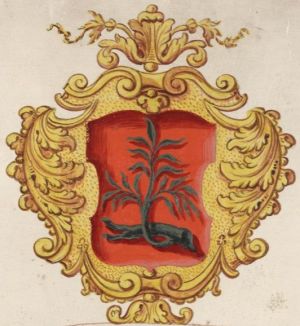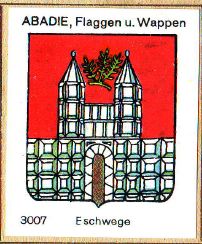Eschwege: Difference between revisions
Knorrepoes (talk | contribs) No edit summary |
Knorrepoes (talk | contribs) m (Text replacement - "]]:S" to "]]: S") |
||
| (38 intermediate revisions by the same user not shown) | |||
| Line 1: | Line 1: | ||
'''ESCHWEGE''' | |||
State:[[Hessen]]<br/> | |||
District (Kreis):[[Werra-Meissner Kreis]] (until 1975 [[Eschwege (kreis)|Eschwege]])<br> | |||
Additions:1936 Niederhone; 1972 Albungen, Eltmannshausen, Niederdünzebach, Niddawitzhausen, Oberdünzebach; 1974 Oberhone | |||
[[File:eschwege.jpg|center|alt=Wappen von {{PAGENAME}}/Arms (crest) of {{PAGENAME}}]] | |||
{| class="wikitable" | |||
|+Official blazon | |||
|- | |||
|'''German''' | |||
| Im roten Schild eine silberne Stadtburg mit zwei Türmen und offenem Tor, zwischen den Türmen ein grüner Eschenzweig. | |||
|- | |||
|'''English''' | |||
| blazon wanted | |||
|} | |||
=== | ===Origin/meaning=== | ||
Eschwege became a city in the early 13<sup>th</sup> century. The oldest known seals date from 1261 and 1282 and show, as do all later seals, the city wall with the two towers. In the 16<sup>th</sup> century the canting ash (Esche) branches were added. The branches were already used as a symbol for the city in the 16<sup>th</sup> century and became the official arms in the early 17<sup>th</sup> century. Until the late 19<sup>th</sup> century the branches remained the official arms of the city, whereas the seals still showed the wall and towers. Since 1884 the city uses the above arms. < | Eschwege became a city in the early 13<sup>th</sup> century. The oldest known seals date from 1261 and 1282 and show, as do all later seals, the city wall with the two towers. In the 16<sup>th</sup> century the canting ash (Esche) branches were added. The branches were already used as a symbol for the city in the 16<sup>th</sup> century and became the official arms in the early 17<sup>th</sup> century. Until the late 19<sup>th</sup> century the branches remained the official arms of the city, whereas the seals still showed the wall and towers. Since 1884 the city uses the above arms. < | ||
| Line 22: | Line 24: | ||
{|align="center" | {|align="center" | ||
|align="center"|[[File:eschwege.hagd.jpg|center]] <br/>The arms in the [[Kaffee Hag albums]] +/- 1925 | |align="center"|[[File:{{PAGENAME}}16.jpg|center|300 px|Coat of arms (crest) of {{PAGENAME}}]] <br/>The arms in a [[:Category:Windhag city arms|16th century manuscript]] | ||
|align="center"|[[File:eschweg2.jpg|center]] <br/>The arms with the branch only, as shown in the Hessisches Ortswappenbuch | |align="center"|[[File:{{PAGENAME}}17.jpg|center|300 px|Wappen von {{PAGENAME}}/Coat of arms (crest) of {{PAGENAME}}]] <br/>The arms in a [https://orka.bibliothek.uni-kassel.de/viewer/image/1500376886085/49/ manuscript from +/- 1730] | ||
|- | |||
|align="center"|[[File:{{PAGENAME}}1884.jpg|center|300 px|Wappen von {{PAGENAME}}/Coat of arms (crest) of {{PAGENAME}}]] <br/>The arms in an 1884 [[:File:De-205.books.jpg|book]] | |||
|- | |||
|align="center"|[[File:eschwegez1.jpg|center|Seal of {{PAGENAME}}]] <br/>Seal from around 1900 | |||
|align="center"|[[File:eschwege.hagd.jpg|center|Wappen von {{PAGENAME}}/Coat of arms (crest) of {{PAGENAME}}]] <br/>The arms by [[Otto Hupp|Hupp]] in the [[Kaffee Hag albums]] +/- 1925 | |||
|- | |||
|align="center"|[[File:3007.aba.jpg|center|Arms (crest) of {{PAGENAME}}]] <br/>The arms in the [[Abadie]] albums | |||
|align="center"|[[File:eschweg2.jpg|center|Wappen von {{PAGENAME}}/Coat of arms (crest) of {{PAGENAME}}]] <br/>The arms with the branch only, as shown in the Hessisches Ortswappenbuch | |||
|} | |} | ||
{{de}} | |||
{{media}} | {{media}} | ||
[[Literature]] : Stadler, K., 1964-1971, 8 volumes; Hessisches Ortswappenbuch, 1956. | [[Civic Heraldry Literature - Germany|'''Literature''']]: Stadler, K., 1964-1971, 8 volumes; Hessisches Ortswappenbuch, 1956. | ||
[[Category:German Municipalities E]] | [[Category:German Municipalities E]] | ||
Latest revision as of 05:51, 13 August 2024
ESCHWEGE
State:Hessen
District (Kreis):Werra-Meissner Kreis (until 1975 Eschwege)
Additions:1936 Niederhone; 1972 Albungen, Eltmannshausen, Niederdünzebach, Niddawitzhausen, Oberdünzebach; 1974 Oberhone
| German | Im roten Schild eine silberne Stadtburg mit zwei Türmen und offenem Tor, zwischen den Türmen ein grüner Eschenzweig. |
| English | blazon wanted |
Origin/meaning
Eschwege became a city in the early 13th century. The oldest known seals date from 1261 and 1282 and show, as do all later seals, the city wall with the two towers. In the 16th century the canting ash (Esche) branches were added. The branches were already used as a symbol for the city in the 16th century and became the official arms in the early 17th century. Until the late 19th century the branches remained the official arms of the city, whereas the seals still showed the wall and towers. Since 1884 the city uses the above arms. <
In 1956, however, a book published by the official government of Hessen shows the older arms again. This resulted in a long dispute whether the branches or the towers were the official city arms. The Hessisches Ortswappenbuch mentiones the branch as arms, whereas Stadler mentions in his later work the above arms.
| The arms in a 16th century manuscript |
The arms in a manuscript from +/- 1730 |
| The arms in an 1884 book | |
| Seal from around 1900 |
The arms by Hupp in the Kaffee Hag albums +/- 1925 |
| The arms in the Abadie albums |
The arms with the branch only, as shown in the Hessisches Ortswappenbuch |
This page is part of the German heraldry portal Deutsche Wappensammlung |
Heraldry of the World |
|
German heraldry:
|
Selected collector's items from Germany:
|
Contact and Support
Partners:
Your logo here ?
Contact us
© since 1995, Heraldry of the World, Ralf Hartemink 
Index of the site
Literature: Stadler, K., 1964-1971, 8 volumes; Hessisches Ortswappenbuch, 1956.



















